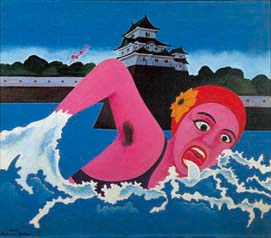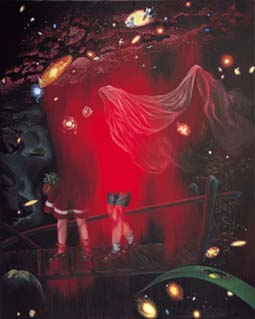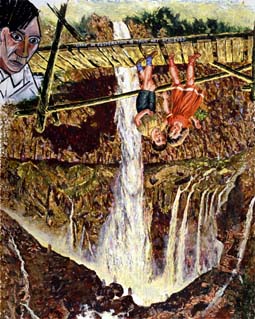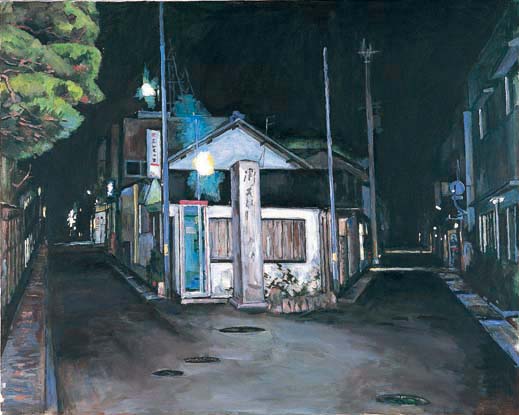 |
Focus features two in-depth reviews each month of fine art, architecture and design exhibitions and events at art museums, galleries and alternative spaces around Japan. The contributors are non-Japanese art critics living in Japan. |
|
|
 |
 |
 |
Repetition as Change: The Opening of the Yokoo Tadanori Museum of Contemporary Art
Christopher Stephens |
 |
 |
|
 |
| Moat (1966, acrylic on canvas, Tokushima Modern Art Museum) |
|
No Goal for Life (2005, oil and acrylic on canvas, National Museum of Art, Osaka) |
Though well into his seventies, Tadanori Yokoo (b. 1936) is still a man on a mission. Since making his name as a graphic designer in the 1960s, Yokoo has pursued a bewildering number of creative paths and expressed his singular artistic vision in every type of media, from posters to painting, TV to Twitter. And due perhaps to his formative experiences in the advertising world, Yokoo was the first Japanese artist to realize the commercial potential of his work by publishing a handful of books every year and producing a full line of official merchandise that includes clothing, dishes, and plastic figurines.
Now, with an eye on his legacy, Yokoo has returned to his roots in Hyogo Prefecture and opened his own museum. Y+T MOCA (Yokoo Tadanori Museum of Contemporary Art) is housed in a wing of the former Hyogo Prefectural Museum of Modern Art (the museum was forced to relocate to a newly constructed facility after the Great Hanshin-Awaji Earthquake in 1995). It also happens to be located within steps of the house where Yokoo lived with his wife just prior to moving to Tokyo in 1960. The museum's inaugural exhibition, Han-han-puku-puku-han-puku (continuing through mid-February 2013), focuses on repetition in the artist's work as seen in some 90 paintings dating from the mid-'60s to 2012. Examples include the image of a woman swimming in a castle moat with her mouth agape, eyes agog, and a pained expression on her face; she seems either to be on the verge of swallowing all of the water or being engulfed by it. Since making the original painting (Moat) in 1966, Yokoo has frequently revised the motif, reversing the direction of the swimmer, changing her skin color, adding a second figure, modifying the castle in the background, or switching the scene to a public bath.
Tadanori Yokoo was first acclaimed for a series of posters he designed in the 1960s for underground dance and theater productions by now legendary figures like Tatsumi Hijikata and Shuji Terayama. Still his most powerful works, these brilliantly-colored collages combine stereotypical Japanese images like rising suns, Hokusai-style waves, Mt. Fuji, and geisha with English and Japanese lettering and photographs. With a touch of surrealism and a Pop sensibility, Yokoo's posters came to exemplify the era in the same way that Peter Blake and Peter Max's work did in the West. But unlike those artists, Yokoo has continuously displayed a restless urge to evolve. Remaining keenly aware of cultural change, he has never allowed himself to become a relic of the past.
 |
|
 |
| Destiny (1997, acrylic on canvas, artist's collection) |
|
Picasso in the 20th Year (2001, oil and collage on canvas, artist's collection) |
In 1980, after seeing a Picasso retrospective in New York, Yokoo renounced design and set out to become a full-fledged painter. Waterfalls were his first graphic obsession. Yokoo traveled around the world to see them, collected postcards of them, and made huge pictures of them. Next, inspired by the discovery of a peculiarly-shaped building at a fork in the road in his hometown of Nishiwaki, Yokoo turned his gaze on Y junctions, a motif that proved to be rich in compositional and conceptual possibilities. After searching for dozens of similar spots in the Kanto region and committing them to canvas, Yokoo made his first foray into photography, returning to the sites with a camera and waiting patiently for the brief moment when all vehicles and passersby disappeared to capture desolate scenes that transcend time and space. In recent years, Yokoo has tended toward dreamlike scenes that combine boy adventurers from stories he loved as a youth, numbered objects or figures, and small portraits of famous artists and writers, including his early champion and friend Yukio Mishima. These motifs are sometimes jumbled together in secret grottoes alongside nude bathing beauties, religious icons, and downed fighter planes.
As the current exhibition makes clear, any image that has appeared in Yokoo's work in the past might well resurface at some point in the future. But when it does, it is likely to assume a new form or to be combined with something entirely different. Yokoo endlessly references himself, recycling and reimagining previous motifs and styles, and arriving at something similar but never the same. Yokoo also turns to other artists for inspiration, liberally quoting from or copying Picasso, Rubens, and de Chirico among many others. Other mainstays in the artist's work are humor and erotica. In Cosmic Firefly (1997), for example, fireflies perched on green orbs float through a corroded scarlet and black sky above the legs of two boys (the rest of their bodies have vanished) walking carefully along a narrow wooden bridge. There is another small circle overhead showing the silhouette of a couple engaged in intercourse in what seems to be an excerpt from a cheap guide to sexual positions, suggesting perhaps that the adolescent mind is mostly filled with insects and budding carnal desires.
Though repeating one's self has come to be seen as a sign of artistic failure, Tadanori Yokoo has embraced it not only as an inevitable part of the creative process but as a positive form of growth. In Yokoo's work, the more things stay the same, the more they change.
 |
DNF: N City-II (2000, acrylic on canvas, private collection)
All images courtesy of Y+T MOCA |
 |
 |
Christopher Stephens
Christopher Stephens has lived in the Kansai region for close to 25 years. In addition to serving as the editor of the now defunct magazine Kansai Time Out for many years, he has extensive experience as the translator of numerous exhibition catalogues for museums throughout Japan, and art and architecture books such as What's Gutai?, The Architecture of E.G. Asplund: 1885-1940, Salon to Biennial, World Architects 51, Miwa Yanagi: Windswept Women, Tomoko Konoike's Inter-Traveller, and Tadanori Yokoo's Tokyo Y-Junctions. |
|
 |
|